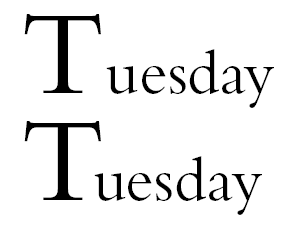A problem often arises with numbers, such as large digits representing the year or the day of the month, as fonts usually specify the same width for all digits. This can be handled, when using QuarkXPress, using a set of saras which add kerning to large numbers from 10 to 19 as well as 21 and 31.

default metric kerning (above) compared to optical kerning (below)

default metric kerning (above) compared to optical kerning (below)
But, in addition to metrics kerning, InDesign also features optical kerning which kerns based of the appearance of each character, and works even between characters of different font sizes and/or different fonts.
When using InDesign, you should always apply optical kerning to the tokens used to display large digits representing the year or the day of the month.
See also: differences between QuarkXPress and InDesign.
Topic 188120, last updated on 22-Jun-2024